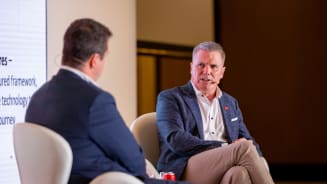In a volatile operating environment, giving risk a seat at the leadership table is more important than ever. From a business resilience and performance perspective, it is essential to invest in an effective and responsive risk management function that is embedded in both strategic planning and executive decision-making. We recently sat down with an industry leader to discuss some of the key steps companies can take to integrate risk management and how this approach can deliver an increase in resilience and business value.
Elevating the role of risk for a whole enterprise
While enhancing the risk governance, practice and culture across an entire enterprise may seem like a daunting goal for a business covering more than 100 million consumers in Japan, Dr Gerold Knight, Chief Risk Officer for Coca Cola Bottlers Japan Inc. (CCBJI) is doing just that. One of the key steps he says, is being embedded in the executive leadership team and having a seat at the table for conversations about strategy and growth.
“I call it having an ear at the table, rather than a seat,” he says. “I get to hear about the challenges and activities of CCBJI and understand where we need to balance risk with the potential to leverage an opportunity. Over time it becomes second nature for all our leaders to be alert to these risks and opportunities.”
Linking risk to growth and elevating its value in the eyes of leaders and the business as a whole is critical. “Traditionally, risk isn’t seen as a driver of growth and innovation,” says Dr Knight. “But leaders need to be ready to take risks and not be afraid of failure.”
An increase in cadence fosters a risk-smart business culture
As with any enterprise-wide initiative, executive level support is essential for making risk a priority across the business. But it takes a whole shift in culture and behaviour to bring about a step change in risk awareness and accountability.
For risk to support business resilience, organisations must engage people at every level to become risk ‘managers’ when making plans and decisions. This requires far more frequent conversations about risk and introducing risk at critical points in both business planning, education and business as usual. At CCBJI, Dr Knight has developed a framework to embed regular engagements with risk across the business – from deep dive risk sessions with business functions to quarterly briefings with the audit and supervisory committee.
“A risk register is a way to record risks, but dialogue is the way to manage them,” says Dr Knight. “We have conversations with each of the functions about their plans and activities. Rather than telling them what their risks are, we give them a risk management mindset by asking what’s keeping them awake at night for business planning and in their day-to-day operations. As a result, they start taking ownership of evaluating the risk in their decision-making.”
“It is important to have our people alert to risks, but it is inevitable that bias will come into play. This is why we’re running AI through our deep dive conversations to validate themes we’re identifying and using an external data overlay alongside this to check if we are capturing and acting on the relevant risks.”
Dr Gerold Knight
Chief Risk Officer, Coca Cola Bottlers Japan (CCBJI)






























































































































































































































































































































































